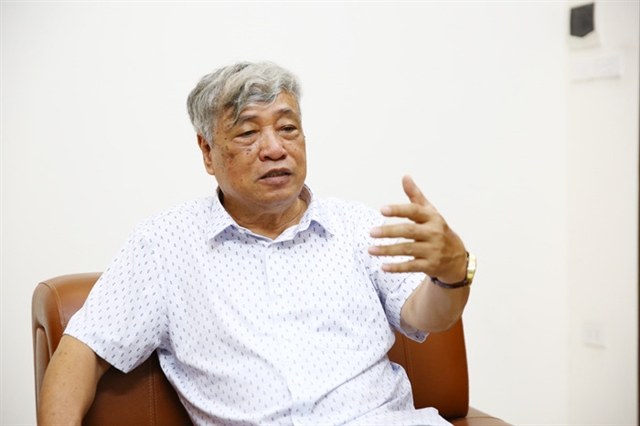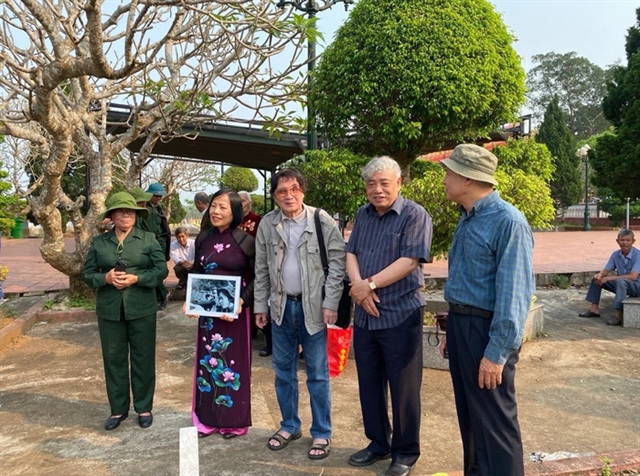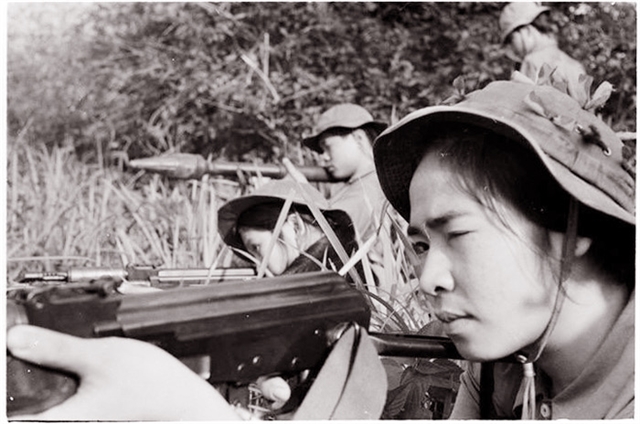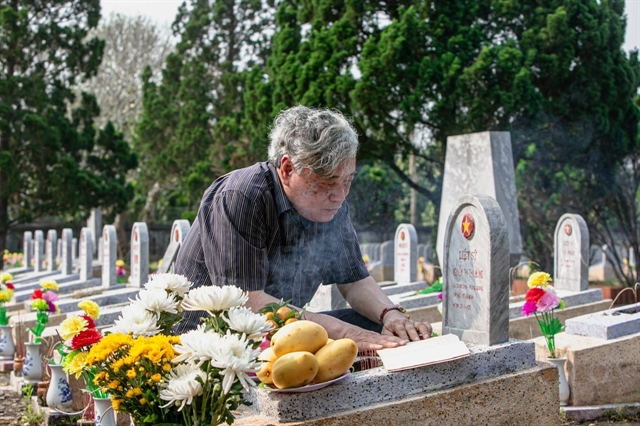
FULL OF MEMORIES: Veteran journalist Trần Mai Hưởng. — Photo courtesy of Hưởng
Trần Mai Hưởng, former General Director of Vietnam News Agency (VNA), a renowned journalist, witnessed the country's historic moment on April 30, 1975, at the Independence Palace in HCM City. On the 99th anniversary of Việt Nam Revolutionary Press Day (June 21, 2024), Việt Nam News spoke with Hưởng about his memories and thoughts on journalism today.
As an experienced journalist, how do you view journalism today?
I think journalism is a necessary and important job, a noble profession that requires a lot of dedication and sacrifice. At VNA, there were more than 260 journalist martyrs. I once wrote a poem about war correspondents, calling them "people who write history with their blood in fire and bullets."
During the war, it was important to be present and witness historical events and reflect them with news, articles and images, and the great truth of the heroic fight of the people, officers, and soldiers on all battlefields. Those working as journalists often had to overcome many hardships, and sometimes sacrifice their lives.
Today, Việt Nam is peaceful and developing strongly, and journalism has changed a lot, but I think journalism is still crucial. The journalist's vocation is to contribute to the country's development so it can be a "strong country as well as fair, democratic and civilised society."
In the process of globalisation, the challenges of journalism today are huge. More and more information channels, developments in science, technology, and social networks make the media's bridging role challenging. This requires press agencies and journalists to make efforts in competing for information and attracting readers, while still ensuring accuracy and trustworthiness.
How did you get into journalism?
When I was young, I didn't think I would become a journalist. At that time, I had a passion for literature and writing, but I loved to study maths, physics, and chemistry, so I thought I would study at a technical or economics university.
In 1968, I was surprised when I received a summons to study at the University of Physical Education and Sports because in my resume, my teacher wrote my talent was to play table tennis well, even though my school profile was good.
I wondered whether I should go to the University of Physical Education and Sports as I didn't really like it. Fortunately, fate came to me when the person in charge of training at the VNA sent a letter to my father inviting me to attend the eighth journalist training class organised by VNA.
I was the youngest in the class, only 16 years old. The more I studied, the more I liked journalism, the profession gradually sank in and I wanted to try harder. After finishing the training course, I went to work at the bureau of the VNA in Hà Tây Province (now part of Hà Nội). During 1971-1972, I worked and learned how to write news articles. I also self-study through books borrowed from the library. Two years later, I was sent to work as a war correspondent.

Journalists Trần Mai Hưởng, Trần Mai Hanh (second and third from right) and Thu Lan (the person holding the photo, sister of martyr Thu Hồng) offer incense at Gio Linh Martyrs Cemetery in April, 2024. — Photo courtesy of Hưởng
You only had two years of work and study before you entered the battlefield?
That's right. In 1972, I received orders to go to the battlefield, at that time I was only 20 years old. Doing journalism on the battlefield is difficult. Besides the bombs and sacrifices, the most important thing for a reporter was to be able to write - to have a journalistic product. Writing news stories and taking photos on the battlefield was difficult, but sending them back to the agency was even more difficult, requiring great effort, even blood.
There is a memory I will always remember. In 1972, after liberating Đông Hà Town, Quảng Trị Province, I returned to Bích La Đông Village, Triệu Phong District to meet and speak with people about their new life in the newly liberated land, including the family of Lê Duẩn, First Secretary of the Party Central Committee.
I asked the local authorities to invite Duẩn's relatives to the Lê family church to take a photo. More than 30 people were in the photo and I clearly annotated each person then sent it to Hà Nội. Then I wrote the article "Liberation of Bích La Đông," which was published in many newspapers at that time. Later, I heard that the photos I took at Bích La Đông were enlarged and sent to Duẩn. He was very touched because he saw images of his hometown, family and neighbours.
How did it happen that you were sent back to the battlefield in 1975?
It's a story of fate. In early 1975, I was at work in Hà Nội when I was informed that I would go to work at the bureau of the VNA in Vĩnh Linh (Quảng Bình) to replace journalist Phạm Tài Nguyên.
Near the Lunar New Year General Đồng Sĩ Nguyên - Commander of the Trường Sơn Army inspected the battlefield, visited the border area and worked with the Vĩnh Linh Regional Party Committee. I was able to attend that meeting. During the meeting, through the information I gathered, I felt that a big campaign was about to take place.
After that, I returned to Hà Nội to continue to study at National Economics University. As the Vietnamese army attacked Buôn Ma Thuột in March 1975, on a day off from university, I went to the office and saw there were several groups of journalists preparing to enter the battlefield.
I immediately met journalist Lê Châu, Deputy Head of the Northern Photo News Department, and asked to go. But Châu said that the delegations were full, and I was still studying so the agency did not want to send me. But, seeing my determination, he said that if I wanted to go, the only way was to meet journalist Đỗ Phượng, Deputy General Director of the VNA. That afternoon, I went to see Phượng and asked to return to the battlefield. He agreed.
And how were you lucky enough to be one of the first reporters present in Huế and Đà Nẵng on the first day of liberation?
In mid-March 1975, when Huế was about to be liberated, our group of five people went by car to Mỹ Chánh Village, Quảng Trị Province when the bridge collapsed. We decided to walk all night, crossing a distance of 40 km, in a war zone, to enter Huế. Arriving in Huế, we immediately divided up the work, and I wrote the first article about liberated Huế with the title "Huế đỏ cờ bay" (Huế in the red colour of the national flags).
I was in Huế for a few days when I heard that Đà Nẵng was liberated on March 29, 1975. We immediately borrowed two motorcycles to go to Đà Nẵng. We went to the airport, then along the Hàn River, Trịnh Minh Thế Bridge, and on to Sơn Trà, to enter the enemy command post and get documents. After collecting the information, I took a motorcycle alone from Đà Nẵng to Đông Hà, Quảng Trị Province, carrying films and photos. Upon arrival, I quickly wrote six pages: "Đà Nẵng's first day of liberation" to be sent to Hà Nội.
However, I immediately received news that due to bad weather, Hà Nội did not receive my manuscript. So at 9.30 pm, we used the signal machine to send the article to the office in Hà Nội and finished it after midnight. Around 5 am, Voice of Việt Nam broadcast the article. We listened together, swallowing every word and overflowing with emotion.
After the liberation of Huế, our group followed Army Corps 2 in an old car. Along the way, I searched for directions, met with party committees and several people to write articles, and sent them to Hà Nội.
At the same time, another group of journalists followed the soldiers to Đà Lạt. My colleague, journalist Đinh Quang Thành stopped by the headquarters of the Sài Gòn Army's Map Department to take photos and find a map that Thành later gave to the Army Corps 2, helping the soldiers find their way and organise their attack lines. That map is now at the Museum of Army Corps 2.
Following that route, I was lucky enough to be in Sài Gòn (now HCM City) to take the iconic photograph of a Vietnamese Army tank going through the gate of the Independence Palace on April 30, 1975, marking the end of a long and bloody war against the US.

IMMORTALIZED: The photo of female guerrilla Thu Hồng was taken by journalist Trần Mai Hưởng in 1972, a few months before her death. — Photo courtesy of Hưởng
How was it when you revisited many of the old places you had been at during the war?
In April, my brother Trần Mai Hạnh and I went on a trip across Việt Nam with some friends. A very memorable memory of this trip was when I returned to Gio Linh Cemetery, burning incense to commemorate martyr Thu Hồng and the heroes and martyrs there. After that, we met Thu Lan, martyr Hồng's younger sister. Hồng is the character whose portrait I took while she was shooting a gun. The photo of Hồng is in my newly published book. That was also one of the first photos I took when I entered the Quảng Trị Battle in early 1972.

Journalist Trần Mai Hưởng at the grave of martyr Thu Hồng in April, 2024. — Photo courtesy of Hưởng
On this occasion, Lan invited Hồng's old teammates for us to meet each other. I read the poem "Age of 20" written about Hồng. Through Lan, I had more contact with Quảng Trị's guerrillas in the past.
During the trip, in Đà Nẵng, we had an exceptional meeting with a character in my article "Đà Nẵng's first day of liberation." It was Vĩnh An. She drove VNA's reporters to take photos of Đà Nẵng on the first day of liberation. VNS
OVietnam